engine PONTIAC VIBE 2005 Owners Manual
[x] Cancel search | Manufacturer: PONTIAC, Model Year: 2005, Model line: VIBE, Model: PONTIAC VIBE 2005Pages: 374, PDF Size: 2.49 MB
Page 269 of 374
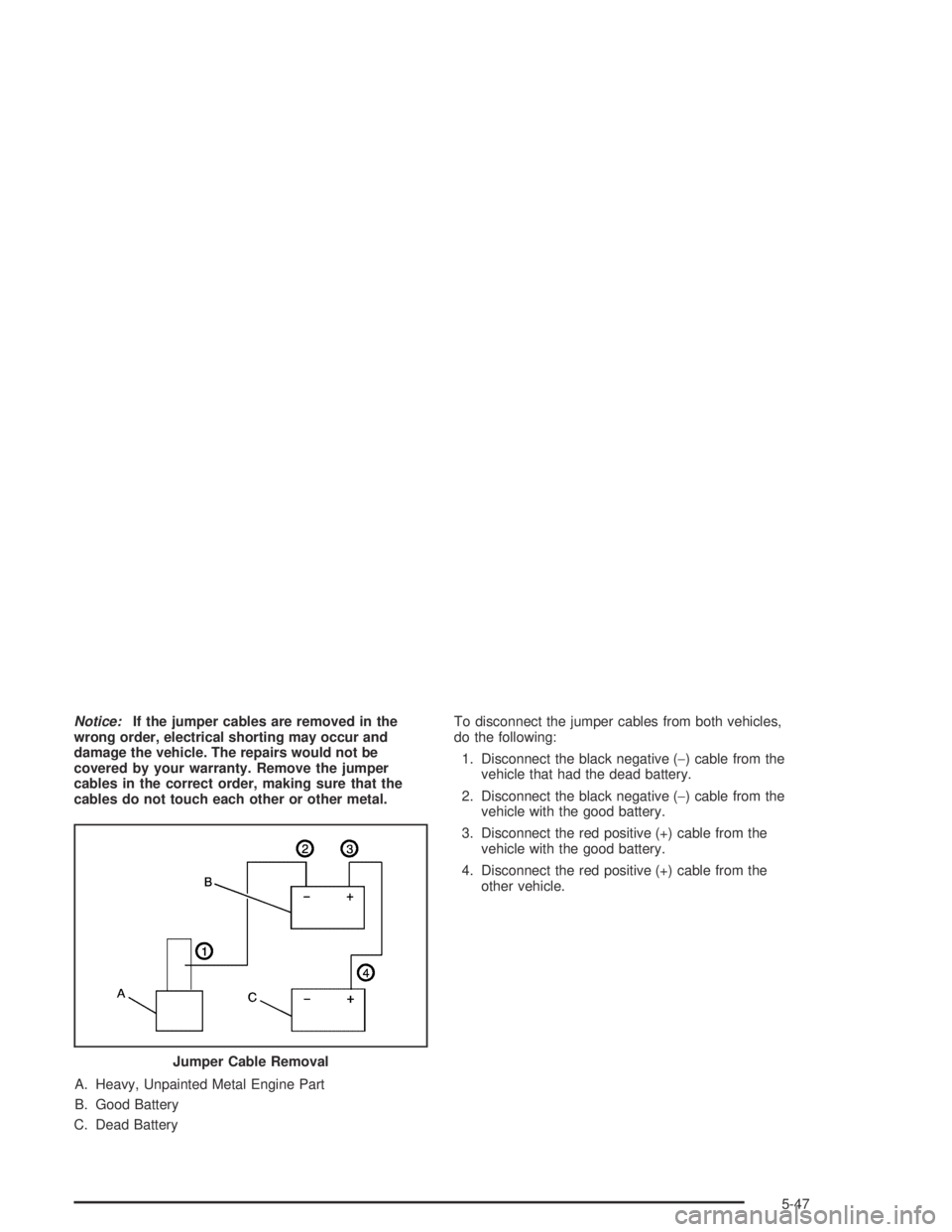
Notice:If the jumper cables are removed in the
wrong order, electrical shorting may occur and
damage the vehicle. The repairs would not be
covered by your warranty. Remove the jumper
cables in the correct order, making sure that the
cables do not touch each other or other metal.
A. Heavy, Unpainted Metal Engine Part
B. Good Battery
C. Dead BatteryTo disconnect the jumper cables from both vehicles,
do the following:
1. Disconnect the black negative (−) cable from the
vehicle that had the dead battery.
2. Disconnect the black negative (−) cable from the
vehicle with the good battery.
3. Disconnect the red positive (+) cable from the
vehicle with the good battery.
4. Disconnect the red positive (+) cable from the
other vehicle.
Jumper Cable Removal
5-47
Page 282 of 374
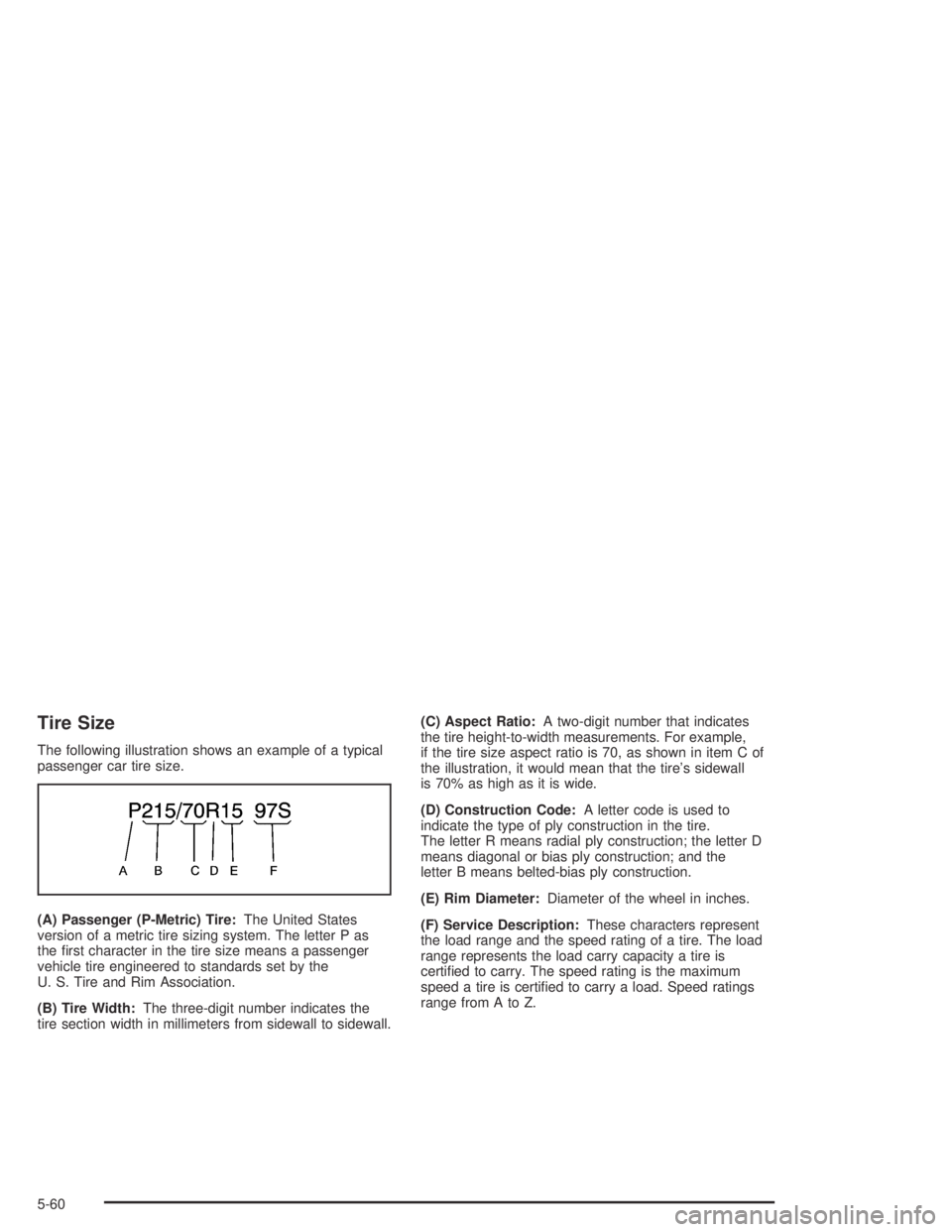
Tire Size
The following illustration shows an example of a typical
passenger car tire size.
(A) Passenger (P-Metric) Tire:The United States
version of a metric tire sizing system. The letter P as
the �rst character in the tire size means a passenger
vehicle tire engineered to standards set by the
U. S. Tire and Rim Association.
(B) Tire Width:The three-digit number indicates the
tire section width in millimeters from sidewall to sidewall.(C) Aspect Ratio:A two-digit number that indicates
the tire height-to-width measurements. For example,
if the tire size aspect ratio is 70, as shown in item C of
the illustration, it would mean that the tire’s sidewall
is 70% as high as it is wide.
(D) Construction Code:A letter code is used to
indicate the type of ply construction in the tire.
The letter R means radial ply construction; the letter D
means diagonal or bias ply construction; and the
letter B means belted-bias ply construction.
(E) Rim Diameter:Diameter of the wheel in inches.
(F) Service Description:These characters represent
the load range and the speed rating of a tire. The load
range represents the load carry capacity a tire is
certi�ed to carry. The speed rating is the maximum
speed a tire is certi�ed to carry a load. Speed ratings
range from A to Z.
5-60
Page 288 of 374

You need to stop as soon as possible and check your
tires for damage. If a tire is �at, seeIf a Tire Goes
Flat on page 5-74andChanging a Flat Tire on
page 5-75. Also check the tire pressure in all four tires,
and set them to the speci�ed level shown on the tire
and loading label. SeeIn�ation - Tire Pressure on
page 5-64for additional information.
Note:The tire pressure monitoring system on
your vehicle will warn you when one of your tires
is signi�cantly under-in�ated and when some
combinations of your tires are signi�cantly
under-in�ated. However, there are other combinations
of signi�cantly under-in�ated tires for which your
tire pressure monitoring system may not warn you.
These other combinations are relatively common,
accounting for approximately half the instances in
which vehicles have signi�cantly under-in�ated tires.
For example, your system may not warn you when both
tires on the same side or on the same axle of your
vehicle are signi�cantly under-in�ated. It is particularly
important, therefore, for you to check the tire pressure in
all of your tires regularly and maintain proper pressure.
In order for the tire pressure monitoring system to
work properly you will need to reset (initialize) the tire
pressure monitoring system. Any time you check and/or
adjust a tire’s pressure, repair or replace a tire or
wheel or rotate the tires the tire pressure monitor system
needs to be reset.Do not reset (initialize) the system without �rst correcting
the cause of the low-tire condition. If the system is
reset when the tire pressures are incorrect, the system
will not function properly and may not alert you when
a tire is low.
To reset (initialize) the system:
1. Park the vehicle at a safe place and apply the
parking brake. Turn the engine off.
2. Turn the ignition to ON with the engine off.
3. If the low-tire pressure
warning light is on,
push the SET (reset)
button for a few
seconds. The low-tire
warning light should go
off. The reset button
is on the instrument
panel to the left of the
steering wheel.
5-66
Page 297 of 374
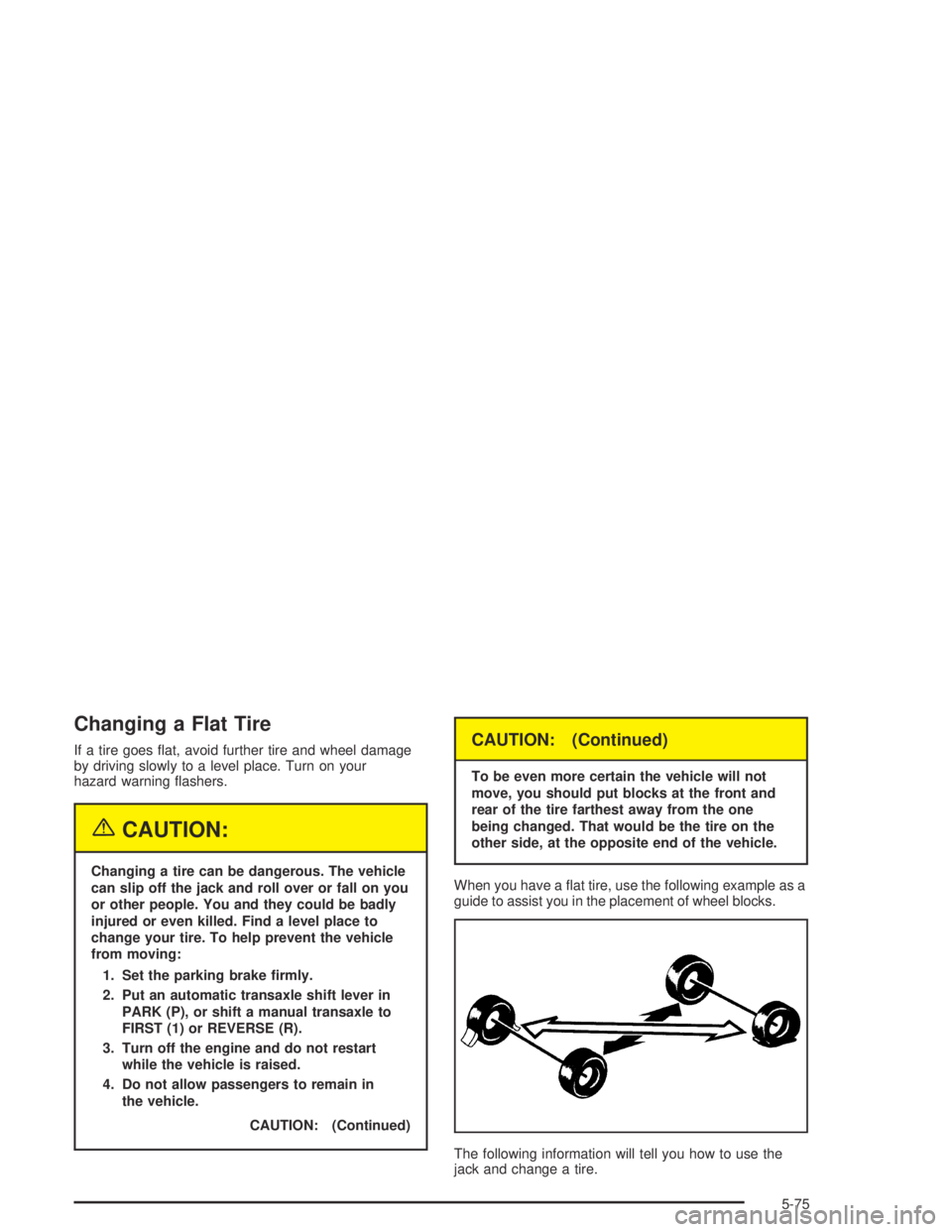
Changing a Flat Tire
If a tire goes �at, avoid further tire and wheel damage
by driving slowly to a level place. Turn on your
hazard warning �ashers.
{CAUTION:
Changing a tire can be dangerous. The vehicle
can slip off the jack and roll over or fall on you
or other people. You and they could be badly
injured or even killed. Find a level place to
change your tire. To help prevent the vehicle
from moving:
1. Set the parking brake �rmly.
2. Put an automatic transaxle shift lever in
PARK (P), or shift a manual transaxle to
FIRST (1) or REVERSE (R).
3. Turn off the engine and do not restart
while the vehicle is raised.
4. Do not allow passengers to remain in
the vehicle.
CAUTION: (Continued)
CAUTION: (Continued)
To be even more certain the vehicle will not
move, you should put blocks at the front and
rear of the tire farthest away from the one
being changed. That would be the tire on the
other side, at the opposite end of the vehicle.
When you have a �at tire, use the following example as a
guide to assist you in the placement of wheel blocks.
The following information will tell you how to use the
jack and change a tire.
5-75
Page 317 of 374

Vehicle Identi�cation
Vehicle Identi�cation Number (VIN)
This is the legal identi�er for your vehicle. It appears on
a plate in the front corner of the instrument panel, on
the driver’s side. You can see it if you look through the
windshield from outside your vehicle. The VIN also
appears on the Vehicle Certi�cation and Service Parts
labels and the certi�cates of title and registration.
Engine Identi�cation
The 8th character in your VIN is the engine code.
This code will help you identify your engine,
speci�cations and replacement parts.
Service Parts Identi�cation Label
You will �nd this label on your spare tire cover. It is very
helpful if you ever need to order parts. On this label,
you will �nd the following:
VIN
Model designation
Paint information
Production options and special equipment
Be sure that this label is not removed from the vehicle.
Electrical System
Add-On Electrical Equipment
Notice:Don’t add anything electrical to your vehicle
unless you check with your dealer �rst. Some
electrical equipment can damage your vehicle and
the damage wouldn’t be covered by your warranty.
Some add-on electrical equipment can keep other
components from working as they should.
Your vehicle has an airbag system. Before attempting to
add anything electrical to your vehicle, seeServicing
Your Airbag-Equipped Vehicle on page 1-60.
5-95
Page 319 of 374
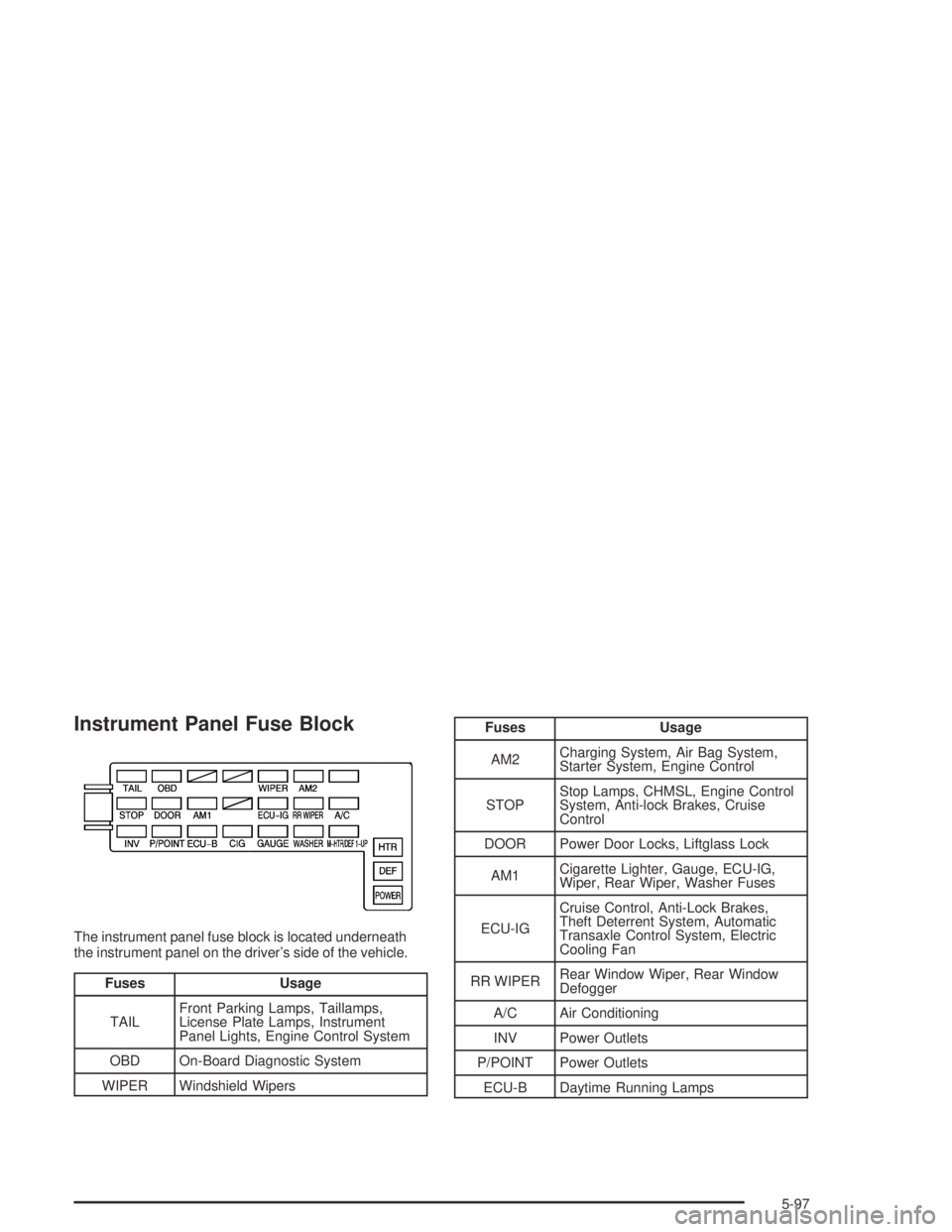
Instrument Panel Fuse Block
The instrument panel fuse block is located underneath
the instrument panel on the driver’s side of the vehicle.
Fuses Usage
TAILFront Parking Lamps, Taillamps,
License Plate Lamps, Instrument
Panel Lights, Engine Control System
OBD On-Board Diagnostic System
WIPER Windshield Wipers
Fuses Usage
AM2Charging System, Air Bag System,
Starter System, Engine Control
STOPStop Lamps, CHMSL, Engine Control
System, Anti-lock Brakes, Cruise
Control
DOOR Power Door Locks, Liftglass Lock
AM1Cigarette Lighter, Gauge, ECU-IG,
Wiper, Rear Wiper, Washer Fuses
ECU-IGCruise Control, Anti-Lock Brakes,
Theft Deterrent System, Automatic
Transaxle Control System, Electric
Cooling Fan
RR WIPERRear Window Wiper, Rear Window
Defogger
A/C Air Conditioning
INV Power Outlets
P/POINT Power Outlets
ECU-B Daytime Running Lamps
5-97
Page 320 of 374
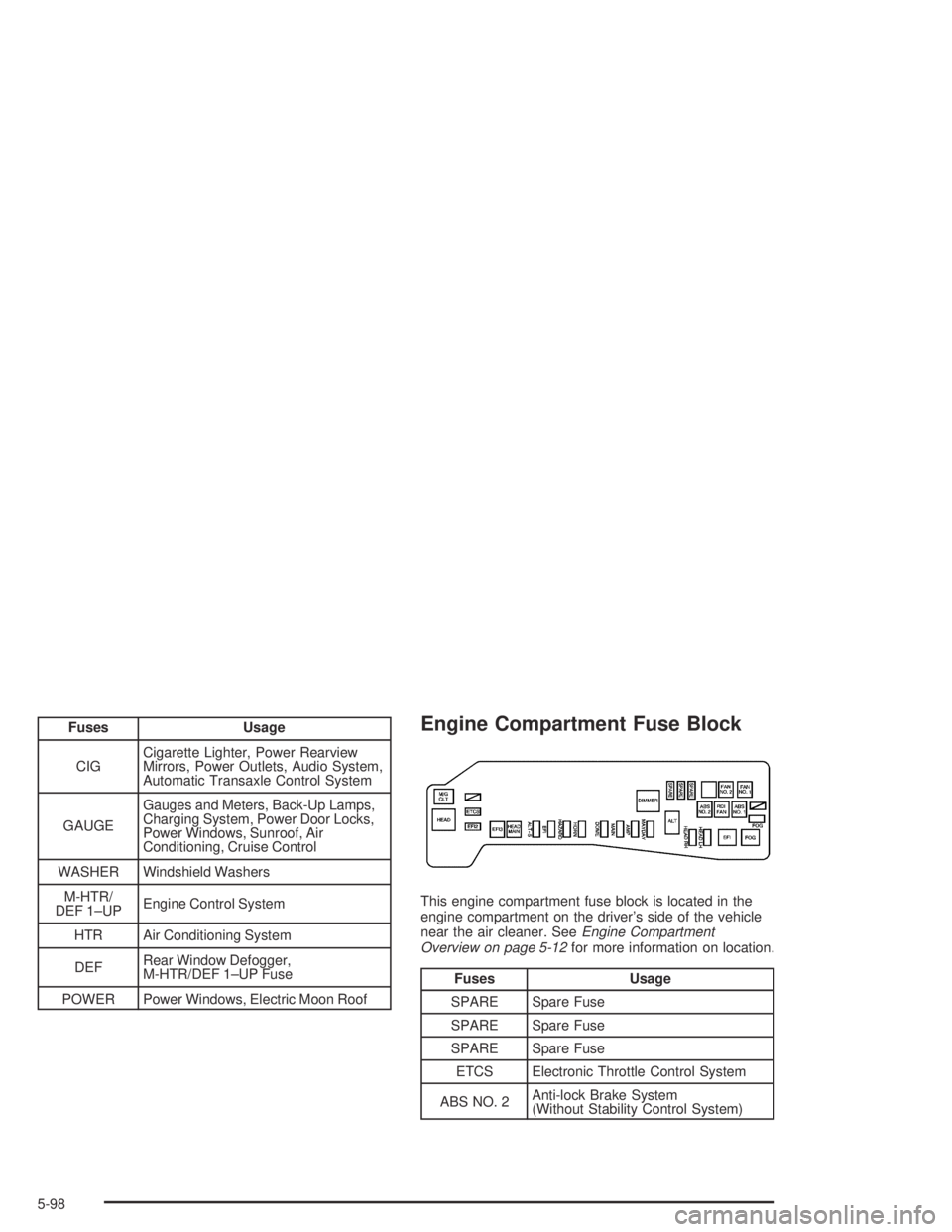
Fuses Usage
CIGCigarette Lighter, Power Rearview
Mirrors, Power Outlets, Audio System,
Automatic Transaxle Control System
GAUGEGauges and Meters, Back-Up Lamps,
Charging System, Power Door Locks,
Power Windows, Sunroof, Air
Conditioning, Cruise Control
WASHER Windshield Washers
M-HTR/
DEF 1–UPEngine Control System
HTR Air Conditioning System
DEFRear Window Defogger,
M-HTR/DEF 1–UP Fuse
POWER Power Windows, Electric Moon RoofEngine Compartment Fuse Block
This engine compartment fuse block is located in the
engine compartment on the driver’s side of the vehicle
near the air cleaner. SeeEngine Compartment
Overview on page 5-12for more information on location.
Fuses Usage
SPARE Spare Fuse
SPARE Spare Fuse
SPARE Spare Fuse
ETCS Electronic Throttle Control System
ABS NO. 2Anti-lock Brake System
(Without Stability Control System)
5-98
Page 322 of 374

Capacities and Speci�cations
The following approximate capacities are given in English and metric conversions.
ApplicationCapacities
English Metric
Air Conditioning Refrigerant R134a 1.47 lbs 0.67 kg
Automatic Transaxle
1.8L (Code 8)
1.8L (Code 8) with AWD
1.8L (Code L)3.2 quarts
3.1 quarts
4.3 quarts3.0 L
2.9 L
4.1 L
Cooling System
1.8L (Code 8)
1.8L (Code L)6.9 quarts
7.1 quarts6.5 L
6.7 L
Engine Oil with Filter
1.8L (Code 8)
1.8L (Code L)3.9 quarts
4.8 quarts3.7 L
4.4 L
Fuel Tank
With AWD
Without AWD11.9 gallons
13.2 gallons45.0 L
50.0 L
Manual Transaxle
Five-Speed
Six-Speed2.0 quarts
2.4 quarts1.9 L
2.3 L
5-100
Page 323 of 374
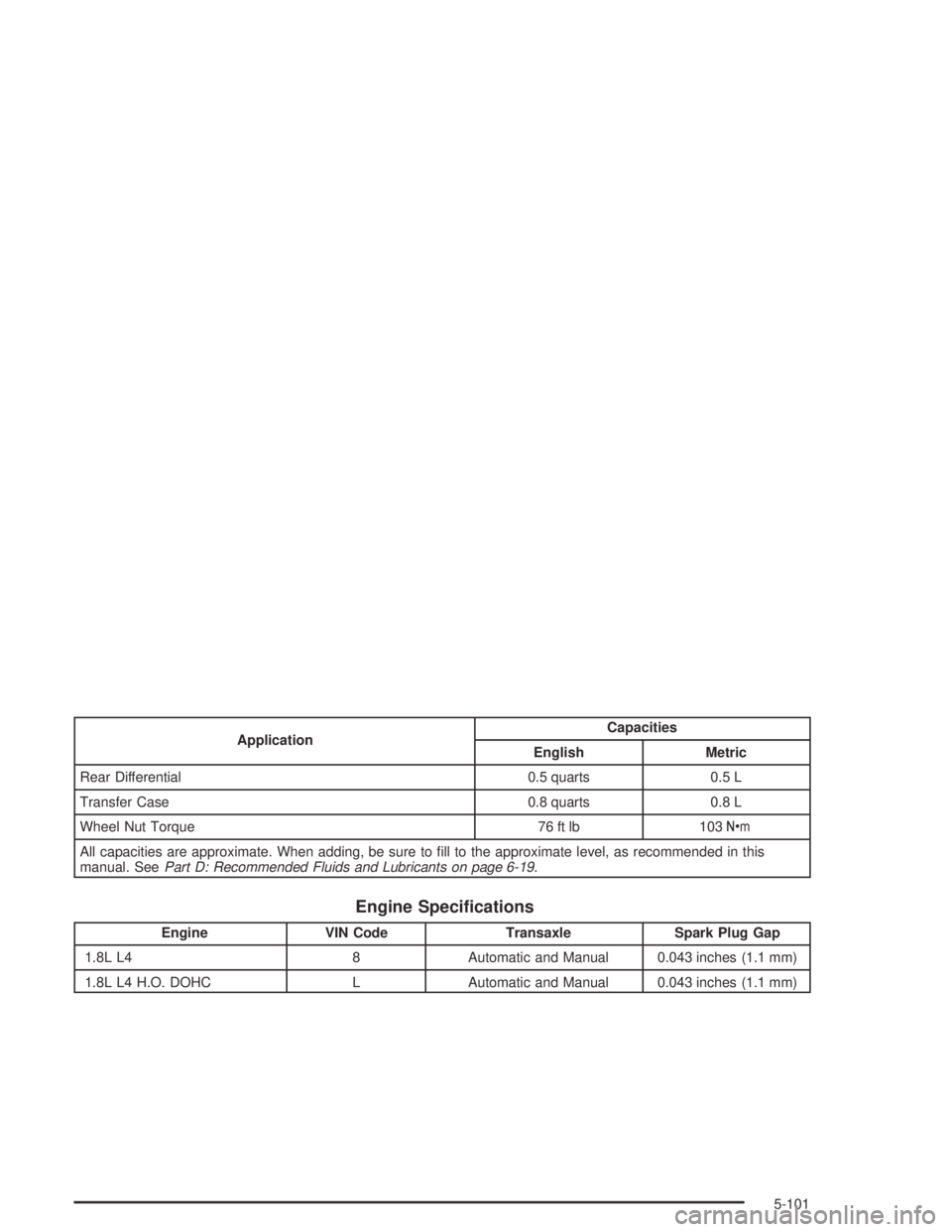
ApplicationCapacities
English Metric
Rear Differential 0.5 quarts 0.5 L
Transfer Case 0.8 quarts 0.8 L
Wheel Nut Torque 76 ft lb 103Y
All capacities are approximate. When adding, be sure to �ll to the approximate level, as recommended in this
manual. SeePart D: Recommended Fluids and Lubricants on page 6-19.
Engine Speci�cations
Engine VIN Code Transaxle Spark Plug Gap
1.8L L4 8 Automatic and Manual 0.043 inches (1.1 mm)
1.8L L4 H.O. DOHC L Automatic and Manual 0.043 inches (1.1 mm)
5-101
Page 324 of 374
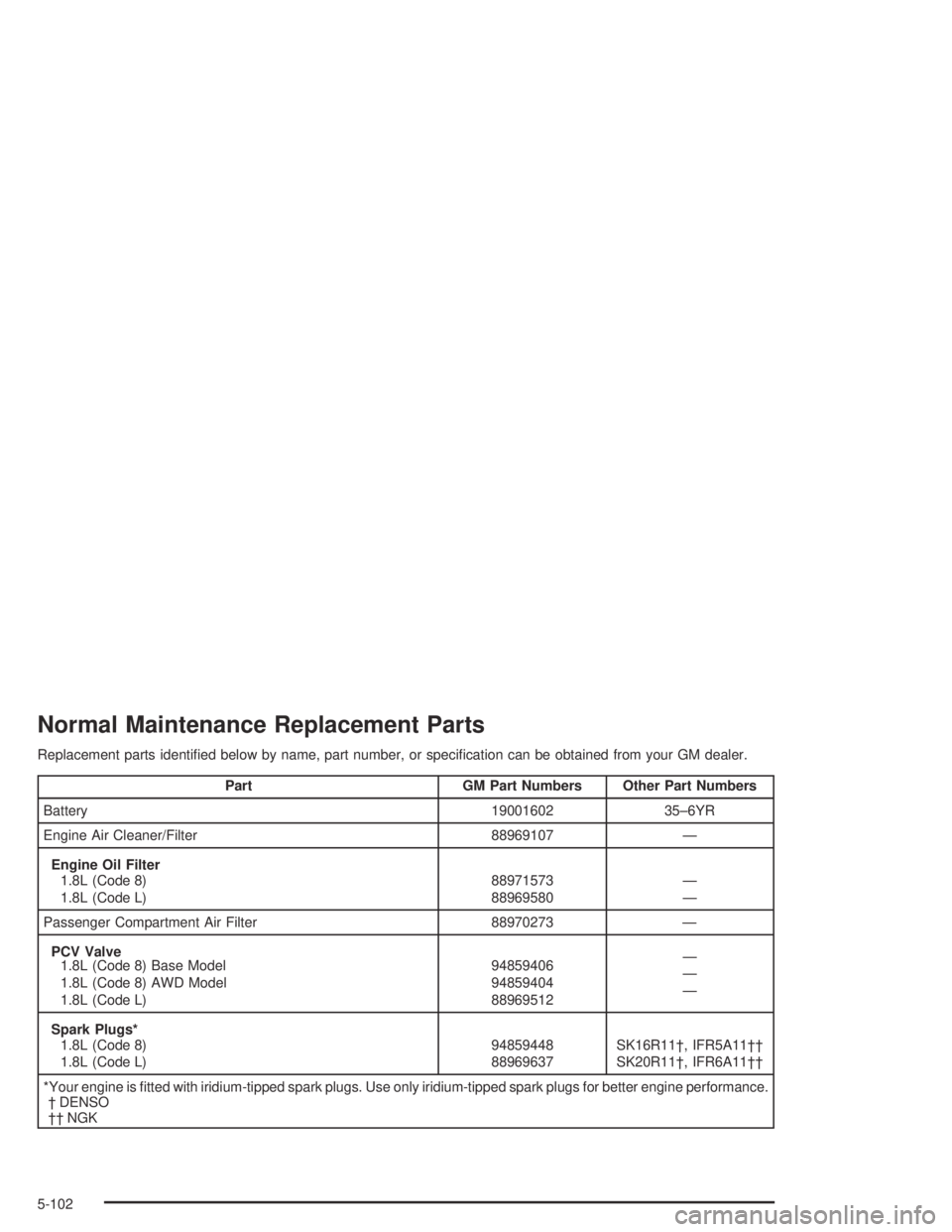
Normal Maintenance Replacement Parts
Replacement parts identi�ed below by name, part number, or speci�cation can be obtained from your GM dealer.
Part GM Part Numbers Other Part Numbers
Battery 19001602 35–6YR
Engine Air Cleaner/Filter 88969107 —
Engine Oil Filter
1.8L (Code 8)
1.8L (Code L)88971573
88969580—
—
Passenger Compartment Air Filter 88970273 —
PCV Valve
1.8L (Code 8) Base Model
1.8L (Code 8) AWD Model
1.8L (Code L)94859406
94859404
88969512—
—
—
Spark Plugs*
1.8L (Code 8)
1.8L (Code L)94859448
88969637SK16R11†, IFR5A11††
SK20R11†, IFR6A11††
*Your engine is �tted with iridium-tipped spark plugs. Use only iridium-tipped spark plugs for better engine performance.
† DENSO
†† NGK
5-102